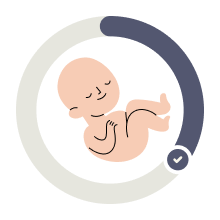As you enter your 26th week of pregnancy, your growing baby is becoming more stable. Along with the excitement of her development, you may also be experiencing some pregnancy-related discomforts. These can include finding comfortable sleep positions, dealing with Braxton Hicks contractions, and uncomfortable intercourse.
Read on to learn more about your baby’s growth and how to manage these common discomforts during pregnancy.
Pregnancy Week 26 Quick Facts
- At 26 weeks, you’re six months pregnant
- You have 14 weeks until your due time “Calculate Your Due Date”
- You’re in your second trimester
Your Unborn Baby’s Size at 26 Weeks
How Big is Baby?
At this stage, your baby is almost the size of a zucchini, with well-defined eyebrows and eyelashes, and more hair on the head.
Baby’s length is approximately 14.02 inches, and the weight is around 1.68 pounds.
Pregnancy Symptoms Week 26
As the second trimester draws to a close, you might still be feeling well, but you could also be encountering typical symptoms such as
- Braxton Hicks contractions
- Nasal congestion
- leg cramps
- Mild swelling in your ankles
- Back pain
- Rib Pain
- Stretch marks
As your belly and baby continue to expand, you may also start experiencing rib pain and stretch marks.
Why does baby move so much at night?
Many pregnant individuals report that their 26-week fetus is most active during the night. This is a common experience, as most fetuses are more active in the evening or at night. While the reason for this is not fully understood, scientists believe that fetuses are beginning to develop circadian rhythms even before birth. So, if your baby’s activity level increases when it’s time to sleep, you’re not alone!
Start talking
It’s a good idea to start communicating with your baby if you haven’t already. You can read stories, sing songs, or simply talk about your day, giving your baby an opportunity to hear your voice. Family members and friends can also talk to your belly, allowing your baby to recognize their voices as well.
Consider a Birth Plan:
Now that you are nearing the end of your second trimester, it’s a good time to start considering your birth preferences and jotting down a rough draft of your birth plan. This plan should list your preferences for labor and delivery, including how your healthcare provider, hospital staff, partner, and support team can assist you in having a positive birth experience.
This is a chance to explore your choices, determine what you want and don’t want, address any concerns you may have, and feel more self-assured about what’s ahead.
Prenatal Tests and Doctor’s Appointments
According to CDC recommendations, your healthcare provider may suggest administering the whooping cough (pertussis) vaccine, commonly known as Tdap, to you between the 27th and 36th week of pregnancy to provide protection for your baby after delivery.
– Risk in the 26th week of pregnancy
If you have a high-risk pregnancy, your doctor may order additional specialized tests such as a
- Contraction stress test
- Fetal non-stress test (NST)
- Biophysical profile
- Modified biophysical profile
- Doppler of umbilical artery.
Developmental Milestones
By the 26th week of pregnancy, your baby’s eyes have completed their development, and you can see their eyebrows and eyelashes. As your baby continues to grow, your body may start to show signs of stretching, resulting in skin changes such as stretch marks.
Eyes:
By 26 weeks of pregnancy, your baby’s eyes have fully developed, including all the different parts. your baby may even have visible eyebrows and eyelashes.
Reflexes:
The startle or more reflex, as well as the palmer (hand) and plantar (foot) grasp, are all beginning to appear in your baby, which are reflexes that you’ll notice them exhibiting after they are born.
Reproductive System:
This week, if you’re carrying a male fetus, the testicles may start to move down from the abdomen into the scrotum.
Intestines:
As your pregnancy progresses, your baby’s intestines are developing and growing. They are capable of absorbing increasing amounts of nutrients from the amniotic fluid and producing enzymes to aid in the digestion of sugars, proteins, and fats.
Survival Outside the Womb:
Babies born at 26 weeks are still very premature, but with the help of modern medicine and specialized care in the NICU, they have a high chance of survival. In fact, survival rates can be as high as 85%. As the weeks go by and the baby gets closer to full term, the chances of survival increase and the risk of long-term health issues decreases.
“Pregnancy is typically measured in weeks, not months, and at 26 weeks pregnant, you are six months along. You are approaching the end of the second trimester, and soon you will enter the final stretch of your pregnancy journey.”





